

Of Mice and Men Quotes. Of Mice and Men Themes. Of Mice and Men: Theme Analysis. Theme Analysis When discussing the thematics of Steinbeck's novel, we would do well to first examine the title, which is an allusion to a line of Robert Burns, a Scottish poet: "The best laid schemes o' mice an' men gang aft aglay.
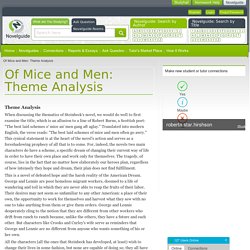
" Translated into modern English, the verse reads: "The best laid schemes of mice and men often go awry. " This cynical statement is at the heart of the novel's action and serves as a foreshadowing prophecy of all that is to come. For, indeed, the novels two main characters do have a scheme, a specific dream of changing their current way of life in order to have their own place and work only for themselves. Major Themes. Introduction Much like Steinbeck's short novel The Pearl, Of Mice and Men is a parable that tries to explain what it means to be human.

His friend Ed Ricketts shaped Steinbeck's thinking about man's place in the universe. Of Mice and Men: Context. John Steinbeck was born in 1902 in Salinas, California, a region that became the setting for much of his fiction, including Of Mice and Men.

As a teenager, he spent his summers working as a hired hand on neighboring ranches, where his experiences of rural California and its people impressed him deeply. In 1919, he enrolled at Stanford University, where he studied intermittently for the next six years before finally leaving without having earned a degree. For the next five years, he worked as a reporter and then as caretaker for a Lake Tahoe estate while he completed his first novel, an adventure story called Cup of Gold, which was published in 1929.
Critical and commercial success did not come for another six years, when Tortilla Flat was published in 1935, at which point Steinbeck was finally able to support himself entirely with his writing. In his acceptance speech for the 1962 Nobel Prize in literature, Steinbeck said: Critical opinions of Steinbeck’s work have always been mixed. Of Mice and Men: Themes, Motifs & Symbols. Themes Themes are the fundamental and often universal ideas explored in a literary work.
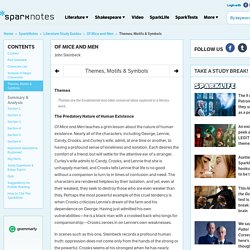
Of Mice and Men: Analysis of Major Characters. Lennie Although Lennie is among the principal characters in Of Mice and Men, he is perhaps the least dynamic.
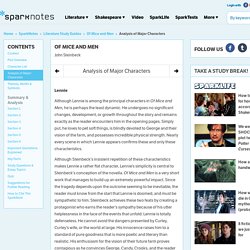
He undergoes no significant changes, development, or growth throughout the story and remains exactly as the reader encounters him in the opening pages. Simply put, he loves to pet soft things, is blindly devoted to George and their vision of the farm, and possesses incredible physical strength. Nearly every scene in which Lennie appears confirms these and only these characteristics. Although Steinbeck’s insistent repetition of these characteristics makes Lennie a rather flat character, Lennie’s simplicity is central to Steinbeck’s conception of the novella. George. Of Mice and Men: John Steinbeck Biography. Early Years John Ernst Steinbeck, Jr., was born on February 27, 1902, in Salinas, California, to a father, John Ernst Steinbeck, who had settled in California shortly after the Civil War, and a mother, Olive Hamilton Steinbeck, who was a public schoolteacher.

Steinbeck grew up in the beautiful, fertile Salinas Valley, and most of his memorable novels and short stories would be set in California. Situated between the Santa Lucia range and the Gabilan Mountains, this valley in west central California is bordered on the north by Monterey Bay and on the south by San Luis Obispo. During his early years, Steinbeck's mother read to him from books such as Treasure Island and Robin Hood. Young John grew up hearing the rhythms of the Bible and listening to the magical stories of the Round Table from Malory's Le Morte d'Arthur. Chapter 6. Summary Lennie is by the deep pool of the Salinas River, waiting for George.

He talks to himself, repeating that George will be mad and give him hell. From his memory, he creates his Aunt Clara, who stares disapprovingly and scolds him because once again he did not listen to George. Then Aunt Clara disappears and is replaced in Lennie's mind by a giant rabbit, who takes Aunt Clara's job of scolding Lennie and tells him he cannot tend the rabbits and that George will beat Lennie with a stick. Lennie protests that George has never "raised his han' to me with a stick. " Chapter 6. Chapter 5. Summary Lennie is alone inside the barn, stroking a dead puppy.
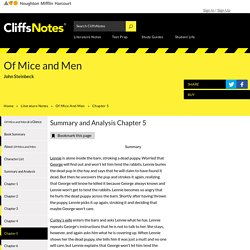
Worried that George will find out and won't let him tend the rabbits, Lennie buries the dead pup in the hay and says that he will claim to have found it dead. But then he uncovers the pup and strokes it again, realizing that George will know he killed it because George always knows and Lennie won't get to tend the rabbits. Lennie becomes so angry that he hurls the dead puppy across the barn. Shortly after having thrown the puppy, Lennie picks it up again, stroking it and deciding that maybe George won't care.
Chapter 4. Summary.

Chapter 3. Summary Alone in the bunkhouse, George thanks Slim for giving Lennie a pup.
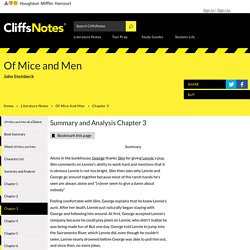
Slim comments on Lennie's ability to work hard and mentions that it is obvious Lennie is not too bright. Slim then asks why Lennie and George go around together because most of the ranch hands he's seen are always alone and "[n]ever seem to give a damn about nobody. " Feeling comfortable with Slim, George explains that he knew Lennie's aunt. After her death, Lennie just naturally began staying with George and following him around. George also confides in Slim about Lennie's trouble in Weed: When Lennie touched a girl's dress, the girl screamed. Carlson enters and complains bitterly about the smell of Candy's dog, offering to shoot it to put it out of its misery.
Chapter 2. Summary The next morning, George and Lennie arrive at the ranch and go to the bunkhouse. The old swamper, Candy, informs them the boss is mad because they were supposed to arrive the night before. After Candy shows them which bunks to take, the conversation turns to people at the ranch, whom he describes. Of Mice and Men: Steinbeck's Of Mice and Men Chapter 1 Summary & Analysis. Summary Two men, dressed in denim jackets and trousers and wearing "black, shapeless hats," walk single-file down a path near the pool. Both men carry blanket rolls — called bindles — on their shoulders. Of Mice and Men: Steinbeck's Of Mice and Men Character List. Lennie Small A migrant worker who is mentally handicapped, large, and very strong. He depends on his friend George to give him advice and protect him in situations he does not understand.
His enormous strength and his pleasure in petting soft animals are a dangerous combination. He shares the dream of owning a farm with George, but he does not understand the implications of that dream. George Milton A migrant worker who protects and cares for Lennie. George dreams of some day owning his own land, but he realizes the difficulty of making this dream come true. Crooks. Crooks is so named because of a crooked back caused by a kick from a horse. Crooks is the stable hand who takes care of the horses and lives by himself because he is the only black man on the ranch. Along with Candy, Crooks is a character used by Steinbeck to show the effects of discrimination.
This time the discrimination is based on race, and Crooks is not allowed in the bunkhouse with the white ranch hands. He has his own place in the barn with the ranch animals. Candy realizes he has never been in Crooks' room, and George's reaction to Crooks being involved in their dream is enough to cause Crooks to withdraw his request to be part of the dream. Crooks also has pride. Crooks is not without his faults, however. Slim. Slim is described always in terms of dignity and majesty. When he first comes into the bunkhouse, he moves "with a majesty achieved only by royalty and master craftsmen.
He was a jerk-line skinner, the prince of the ranch, capable of driving ten, sixteen, even twenty mules with a single line to the leaders. " Slim is tall, ageless, and an expert in his job. His voice is the voice of rationalism. When Carlson suggests killing Candy's dog, Candy appeals to Slim as the final authority. Slim is so respected and admired on the ranch that even Curley listens to him. Curley's Wife. Curley. Candy. Candy is "a tall, stoop-shouldered old man … . He was dressed in blue jeans and carried a big push-broom in his left hand. " Lennie Small. George Milton. George is described as physically small with very sharp features, an opposite to Lennie Small. Of Mice and Men: Steinbeck's Of Mice and Men.
Of Mice and Men by John Steinbeck - review. Of Mice and Men is a well-known classic, and with valid reason. The book may seem rather boring (as many books about the Great Depression may seem) but it is actually a great tribute to literature. John Steinbeck Biography. National Steinbeck Center. Early Years: Salinas to Stanford: 1902-1925. Of Mice and Men: Analysis of Major Characters. GCSE Bitesize: Ranch hands. GCSE Bitesize: John Steinbeck.